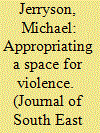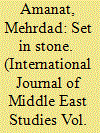| Srl | Item |
| 1 |
ID:
096570


|
|
|
|
|
| Publication |
2009.
|
| Summary/Abstract |
In southern Thailand, monasteries once served as focal points for different communal identities to negotiate shared space and, with it, shared identities. However, since martial law was declared in 2004, Muslims in southern Thailand do not frequent monasteries. Instead, soldiers and police occupy monastery buildings and protect the perimeters from attacks. In addition, there are now military monks, soldiers who are simultaneously ordained monks, who work to protect the monasteries. This article argues that the Thai State's militarisation of monasteries and the role of Buddhist monks fuel a religious dimension to the ongoing civil war in southern Thailand.
|
|
|
|
|
|
|
|
|
|
|
|
|
|
|
|
| 2 |
ID:
113394


|
|
|
|
|
| Publication |
2012.
|
| Summary/Abstract |
Violence toward corpses and graves, especially the unusual practice of exhuming and burning remains, persisted sporadically through the 20th century in Iran but found new dimensions in the form of mass graves and a systematic desecration of cemeteries in the period following the 1979 Islamic Revolution. This paper seeks to explore the roots of cemetery violence by examining the dynamics of apostasy and the experiences and challenges Babi and Baha?i converts faced in their interment practices in the late 19th and early 20th centuries. This period witnessed a significant change in communal identities. Unconventional self-definitions expressed in religious conversions and in fluid or multiple communal affiliations and religious convictions defied traditional boundaries and led to tension between nonconformists and religious authorities. One way for Shi?i ?ulama? and Jewish rabbis to reassert a conventional center was through the control of cemeteries, including by not allowing converts to be buried in these semisacred spaces.
|
|
|
|
|
|
|
|
|
|
|
|
|
|
|
|